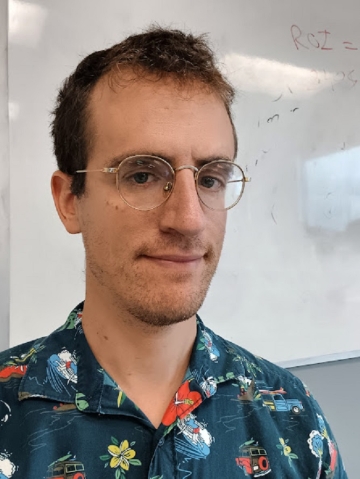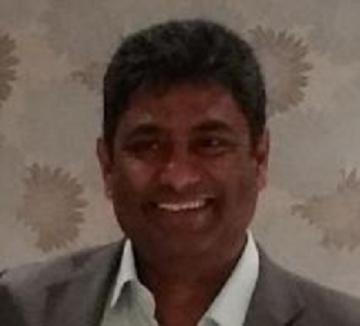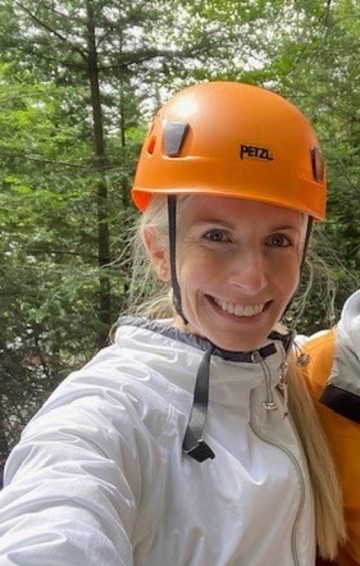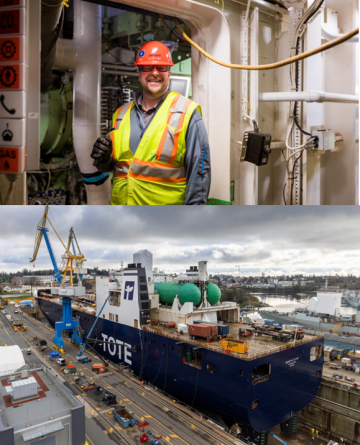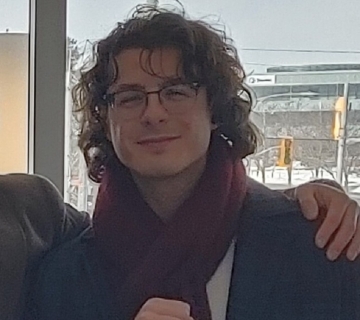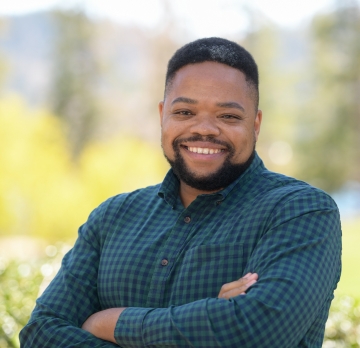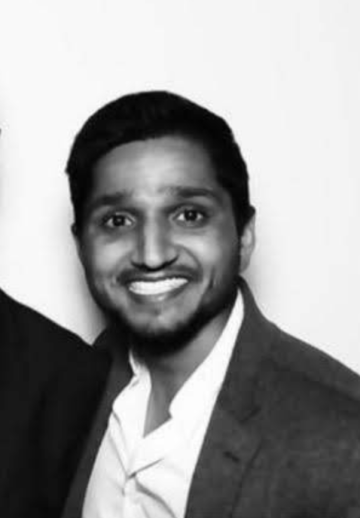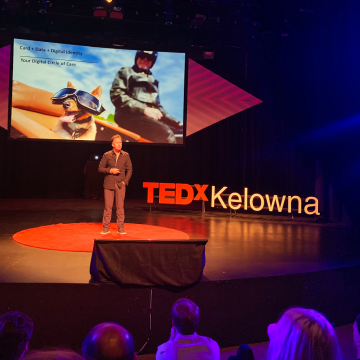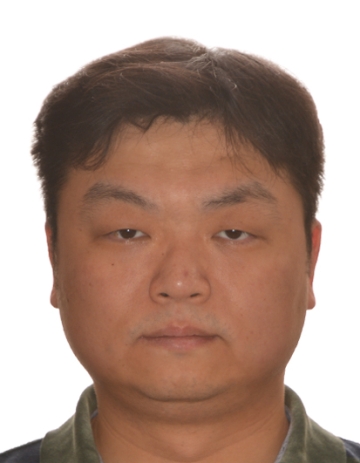Ryan Tuira
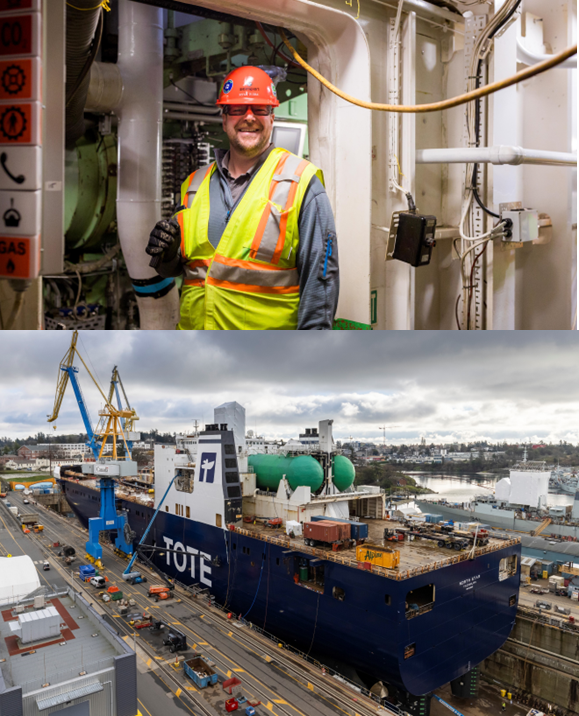
Upper image: Ryan Tuira working onboard a ship. Lower image: Ship being converted to use liquified natural gas (LNG) which will be stored in the two green tanks.

Upper image: Ryan Tuira working onboard a ship. Lower image: Ship being converted to use liquified natural gas (LNG) which will be stored in the two green tanks.
About me
I was born/grew up in: I was born in the lower mainland of Vancouver, B.C. and grew up in the town of Ladner, which is in Delta, B.C.
I now live in: Victoria, B.C.
I completed my training/education at: I went to high school at Delta Secondary School and studied Applied Science (Mechanical Engineering) at the University of British Columbia.
What I do at work
Most of my time in the workplace is spent solving problems for people. Common to these problems is that they have an engineering or science element to them. For example, a customer might want to change their vessel so it will operate on a different fuel. Or it might be related to doing work safely. For example, “how would we lift and install a 400 tonne part on a ship in a safe manner?” To solve these problems, I will meet with the client to learn what work they want to have done to their ship. I’ll then take what I learn from that conversation and develop detailed drawings and work plans so the work can be done. Other times I will be supporting the work of other departments such as estimating, production and procurement.
Physics and math are the science topics that I use in my daily work. At times, I work alone planning projects and, at other times, I will be working as part of a larger team of people working on a vessel when it is in the shipyard. The problems I deal with at work vary from “how we install or remove a large heavy piece of equipment or structure on a ship” to “how we test a very specialized piece of equipment.” Generally, my work does not involve me using specialized equipment. However, the results of my work often require people to use specialized equipment to complete the work scope that I have developed.
Having a background in STEM helps in making decisions. My background helps me look at the problem with an open mind and approach a solution in a disciplined, step-by-step way. One of the recent projects that I have worked on was converting a ship to use liquified natural gas (LNG) as a fuel (see image above). In the lower picture, the green tanks are where the LNG will be stored. These tanks sit on the white supporting structure. Both had to be lifted onto the vessel and installed using specialized lifting equipment. I had to figure out the best equipment to use and then develop the plan to install the parts. This involved a lot of physics and math. Before we can do this type of work on a ship, it must be put in drydock. Putting the ship in the drydock requires specialized equipment and involves physics and math.
My career path is
In high school I decided to pursue engineering because I enjoyed building things and was interested in science. I did not expect to have a career in the marine industry. A friend recommended it as a possible career path after I finished my post-secondary education. While working in the industry, my career path has been influenced by mentors that I have sought out in the industry.
Every industry has its challenges, and the marine industry is no different. Most of the challenges that I deal with are the short timelines. A ship is only in a shipyard for a very short period so you have a limited time to get a project completed. This often makes you think of creative solutions to problems.
I am motivated by
At work I get excited about a large project that has many different groups involved. These projects are generally complex and have a lot of things happening at the same time. I enjoy piecing together the different work scopes into a detailed plan. This plan then gets put into action.
I find it personally rewarding to see how good planning makes the project run smoothly and helps make the team meet or exceed the project goals. It is also always rewarding to see a ship that has had a lot of work done on it leave the shipyard under its own power. This career is the right career for me because I am constantly learning because no day or project is ever the same. The aspect that makes it the most interesting is being exposed to so many different types of ships and projects.
How I affect peoples’ lives
Almost 90 percent of everything we buy arrives by ship. Maritime transport is the backbone of international trade and the global economy. Without shipping you would not be able to have the lifestyle you have. Repairing and maintaining ships is an important service to this industry that has such a large effect on our daily lives. My job makes a difference by ensuring that these ships are safe and fit to work on the world’s oceans.
Outside of work I
When I am not at work, I enjoy being outside hiking or mountain biking. I also volunteer for the Society of Naval Architects and Marine Engineers (SNAME).
My advice to others
My advice for people considering a career in engineering is to be curious and get out of your comfort zone. Be curious in learning from others on the challenges they have come across and what lessons you can learn. When you get out of your comfort zone you are always learning and honing your skills.
- Art
- History
- Industrial Arts / Shop Programs
- Physical Education / Health
- Science
- Technology
- Math
- Always wanted to be outside
- Liked helping people
- Played on a sports team
- Enjoyed working with my hands
- Was motivated by success
- Engaged in volunteer activities
- Liked reading
- Felt at home in the outside, natural environment
- Didn't really care about grades
- Wasn't sure what I wanted to do
- Liked to take things apart to see how they worked
- Engaged in activities such as fishing and berry picking
Related Topics
Partners
Let’s Talk Science appreciates the support of Seaspan Shipyards in connecting us with this individual.
Seaspan Shipyards is a leader in Canada’s shipbuilding and ship repair industry. With modern facilities and a dedicated workforce of 2,700 in North Vancouver and Victoria, Seaspan Shipyards has proven itself to be a trusted partner on a range of complex projects for both government and the private sector. Seaspan Shipyards is proud to be Canada’s chosen non-combat shipbuilder under the National Shipbuilding Strategy (NSS). In this capacity, the company is building state-of-the-art ships in Canada for the Canadian Coast Guard and Royal Canadian Navy. Through its NSS-related work, Seaspan Shipyards is creating jobs, generating economic benefits and rebuilding Canada’s shipbuilding and marine industries.
